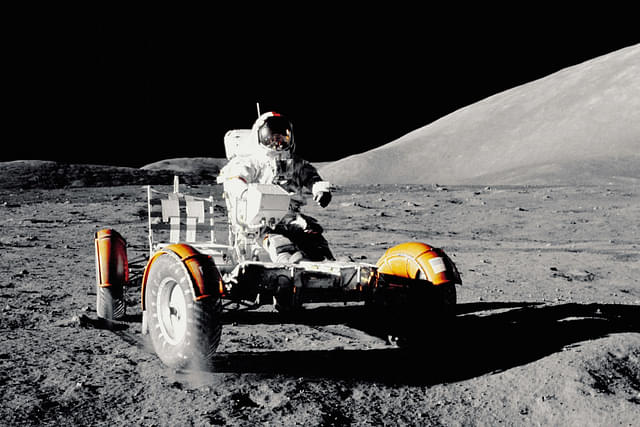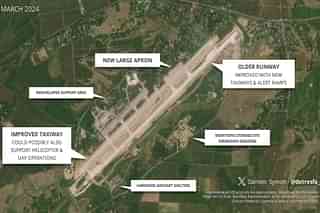Science
Humans Versus Robots For Space Exploration: Who Should Be Going Out There?
Karan Kamble
Apr 05, 2024, 05:54 PM | Updated 05:54 PM IST
Save & read from anywhere!
Bookmark stories for easy access on any device or the Swarajya app.

Human beings last went to space for exploration in 1972. Since then, they have stayed rooted firmly to Earth, travelling at most a few hundred kilometres (km) to orbit, where a couple of space stations are stationed. But that is about to change this decade. The world is once again gearing up for human space exploration.
These last few decades, when human space exploration went quiet, robots — “landers” and “rovers” typically — have made regular, productive, and impactful appearances on the Moon and Mars. Examples of such robots include the Curiosity rover on Mars and the Pragyan rover on the Moon.
If robots are successfully helping advance science in space, why are we once again looking to launch humans into space for exploration, especially when the species is clearly the more vulnerable of the two options in that hostile environment? This is a long-running debate.
Speaking on a podcast recently, British cosmologist, astrophysicist, and Astronomer Royal (an honorary title) Martin Rees questioned whether human spaceflight was worthwhile any more. “Now that robots can do the things that humans were needed for 50 years ago, the case for sending people is getting weaker all the time,” he said.
The distinguished scientist is known for being among the first to propose that quasars are powered by big black holes. He also produced key evidence that disproved the steady state theory, which until then sat alongside the big bang model as a competing explanation for the evolution of the universe.
On the podcast, Rees made the point that those who wished to go into space as an adventure and had a “high appetite for risk” could pursue human spaceflight but at private expense and not drawing from the public exchequer. For “all the practical things, assembling big structures in space, and explore the surface of Mars and all that,” robots would suffice, and robotic exploration could be publicly funded.
Rees has chimed in on a debate that’s gone on for as long as human space flight has existed. Whether it should be humans or robots that should explore the solar system is a question that is especially relevant now, with several human spaceflight programmes currently in the works.
Most prominently, the National Aeronautics and Space Administration (NASA) is heading back to the Moon with astronauts in the latter half of this decade. After having made its last visit to the Moon in 1972, the United States’ space agency wants to not just re-establish human presence but also sustain it there, while also using the Moon as a functioning pitstop for missions to Mars.
India will be marking an entry into human space flight in 2025. It is starting small, by sending two or three humans into a 400-km orbit around Earth. The astronauts will stay up there for a handful of days before returning to the earth with a splashdown in the Arabian Sea.
The Gaganyaan mission, as it is called, will be a stepping stone for India to begin sending its astronauts to the International Space Station, then to build, launch, and maintain its own space station with a crew, called 'Bharatiya Antariksha Station’, in the 2030s, and finally land Indian feet on the lunar surface in 2040.
After having accomplished multiple robotic Moon landings this century, China is looking to become only the second country ever to land humans — “taikonauts” — on the Moon by 2030. They already have the Tiangong space station in Earth orbit where a three-member crew is stationed. These and subsequent planned Chinese missions are part of their human spaceflight programme known as Project 921.
Beyond these and other national human spaceflight missions, prominent figures in science and the space business, such as the renowned theoretical physicist Stephen Hawking, SpaceX chief executive (CEO) Elon Musk, and Virgin Galactic founder Richard Branson, have advocated for humans to become an interplanetary species. The goal is long-term self-preservation.
Musk is committed to the idea of establishing a permanent human presence on the Moon and subsequently on the Red Planet. He envisions his Starship rockets helping ferry people between Earth, Moon, and Mars. “We don’t want to be one of those single planet species,” he said in 2021.
The SpaceX chief was “highly confident” at the time that his company would land humans on Mars by 2026. This is now very likely an unattainable goal since NASA would be trying to land humans on the Moon, which would have to happen before a human visit to Mars, late that year. Moreover, the Artemis missions have been pushed back by a year already, and further delays are possible.
Human space flight is, therefore, back in a big way and here to stay. Nevermind the fact that humans bring along many limiting factors to space — they have to be kept alive by way of specially designed astronaut suits, suitable space vehicles, and safety features like crew escape systems for times of emergency; they have to be fed and their physical and mental health monitored regularly, and, most importantly, they have to be brought back to Earth safely.
Robots, on the other hand, are less demanding. If they are built to withstand and operate in the space environment, as, for example, India’s Vikram lander and Pragyan rover were, they are good to go (as good as can be in the hostility of space). They don’t need to be clothed in particular ways nor do they need to be fed — they can run on energy from the onboard fuel or drawing from the Sun. Most importantly, robots don’t have to be brought back home. And a robotic mission would anyway be cheaper than a human mission — a consideration not to be taken lightly.
Further, robots can comfortably carry out repetitive, mechanical tasks and collect data religiously, even navigating alien terrains that may be off limits or treacherous for humans. They can also stay on the job for time frames that are currently inconceivable for humans in space.
The Opportunity rover, for instance, remained operational on Mars for 5111 sols, an equivalent of 14 years and 138 days on Earth. It far exceeded its planned lifetime of 90 sols, or slightly less than 92.5 Earth days, through smart, continual recharging of batteries using solar power and optimising power use by hibernating during extreme events like dust storms.
In comparison, the longest that humans have lived on the Moon is just under 75 hours, or more than three days. That was during the Apollo 17 mission in December 1972 — the last time humans had their feet on the lunar surface.
However, humans bring incredible advantages: they can get curious about seemingly mundane things and learn something new, think on their feet, get creative with problem-solving, make good, educated guesses based on visual observations and data, pick apart and analyse things, and freshly interpret new, unseen phenomena in ways that robots currently can’t.
Unfortunately, robots are limited by their programming, although advances in artificial intelligence (AI) and robotics might move the needle significantly on this front in the years to come.
Which way should we swing, then, for space exploration — humans or robots?
“If you only care about science, then there’s no rational reason to send humans, really,” science communicator Neil deGrasse Tyson has said, especially with “robots getting better, smaller, cheaper, faster, smarter, all of the above.”
“But here’s the catch,” he adds.
“I have never seen a ticker tape parade for a robot. I have never seen a high school named after a robot. I never saw a kid read a book about a robot and say, ‘Gee, I want to be that robot one day’. There is value of human inspiration. It’s less tangible than the scientific results of an experiment, it’s more emotional, it’s more philosophical, it’s more cultural, it’s more human,” Tyson said.
This aspect of human space exploration — of inspiring a whole generation of people, especially the youth — can never be undermined. Its profound effect on the collective human psyche is hard to overstate.
Several astronauts like Mike Massimino have recalled watching the Apollo 11 Moon landing when they were young and feeling inspired to take up space exploration when they grow up. Others may have taken to science in the academia or industry. Still others may have retained a lifelong hobby of watching the night sky and remaining curious about the natural world.
Science as a whole benefits, too, through bigger budgets, greater support and encouragement for research and development activities, and a stronger public backing, given that space and astronomy are among the top scientific draws in society.
This is seen in India presently. The Indian Space Research Organisation (ISRO) has crossed out one space feat after another over the last one and a half decades. These accomplishments have left, and are continuing to leave, a profound and lasting impression on the minds of not just the people in India but in different corners of the world.
In fact, ISRO might be one of the very few institutions in India today (if not the only) that command love and respect from nearly all people, not succumbing to the divisions of a highly polarised world.
Human space exploration, therefore, offers extraordinary intangible — all too human — benefits that cannot be measured or pinned down by particular numbers. At the same time, the numbers that come from robots doing the hard yards in unfamiliar territories unquestionably underpin vital scientific discoveries.
Therefore, the answer to this question of humans versus machines is boringly but accurately both. Human space exploration and robotic science both have their incredibly important place in advancing our learning about the solar system.
Just as the numbers accompanying the mission name “Chandrayaan” keep rising, so should the numbers associated with Gaganyaan (though there isn’t a number affixed to Gaganyaan just yet), as Indian astronauts learn to live successively in Earth orbit, lunar orbit, the lunar surface, all the way up to the Martian surface and, perhaps, even at the Lagrange points someday.
So, while launchers, landers, orbiters, and rovers go into space repeatedly and frequently to gather data at increasing rates and advance our understanding of the solar system ever more rapidly, humans can come in every so often, like the star player of a sports team, to work their magic and advance the cause of not just science but the human civilisation as a whole.
Also Read: The Tide Turns: West Trails East In The Second Wave Of Moon Missions
Save & read from anywhere!
Bookmark stories for easy access on any device or the Swarajya app.
Karan Kamble writes on science and technology. He occasionally wears the hat of a video anchor for Swarajya's online video programmes.
Introducing ElectionsHQ + 50 Ground Reports Project
The 2024 elections might seem easy to guess, but there are some important questions that shouldn't be missed.
Do freebies still sway voters? Do people prioritise infrastructure when voting? How will Punjab vote?
The answers to these questions provide great insights into where we, as a country, are headed in the years to come.
Swarajya is starting a project with an aim to do 50 solid ground stories and a smart commentary service on WhatsApp, a one-of-a-kind. We'd love your support during this election season.
Click below to contribute.





